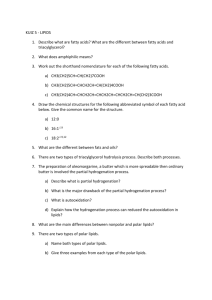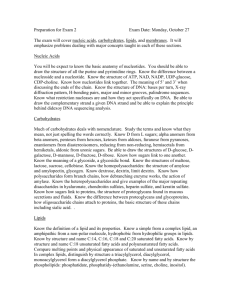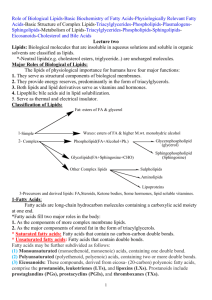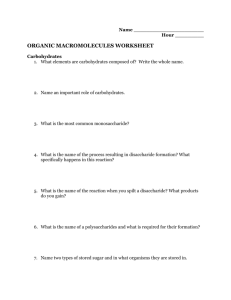2-Lipids part (1) Dr. Nafez Abo-Tarboosh 4-5-6
advertisement
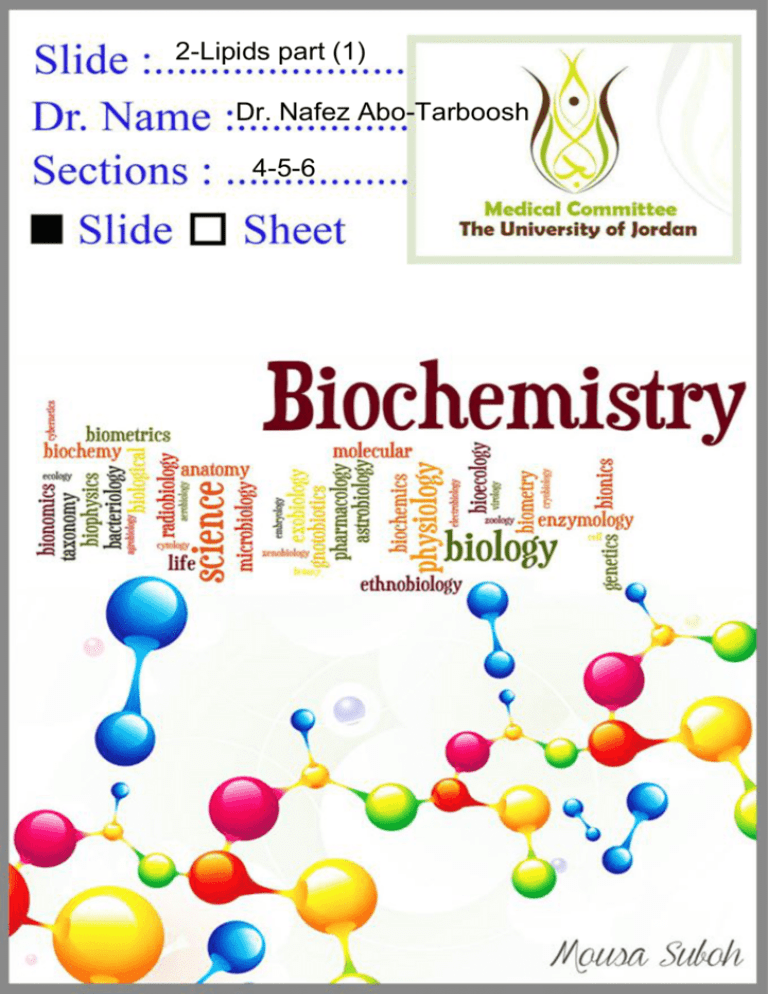
2-Lipids part (1) Dr. Nafez Abo-Tarboosh 4-5-6 Nafith Abu Tarboush DDS, MSc, PhD natarboush@ju.edu.jo www.facebook.com/natarboush A heterogeneous class of naturally occurring organic compounds Formed mainly from alcohol & fatty acids combined together by ester linkage They are Amphipathic in nature Insoluble in water, but soluble in fat or organic solvents (ether, chloroform, benzene, acetone) They are widely distributed in plants & animals 1) They are storable to unlimited amount (vs. carbohydrates) 2) They provide considerable amount of energy to the body (25% of body needs) & provide a high-energy value (more energy per gram vs. carbohydrates & proteins) 3) Supply the essential fatty acids (PUFAs) 4) Supply the body with fat-soluble vitamins (A, D, E & K) 5) They are important constituents of the nervous system 6) Structural (cell membrane): cholesterol & fatty acids 7) Stored lipids are in all human cells & acts as: A. A store of energy B. A pad for the internal organs C. A subcutaneous thermal insulator against loss of body heat 8) Combine with proteins “Lipoproteins” 9) Precursor for: adrenal cortical hormones, sex hormones, vitamin D3 & bile acids Lipids include: Open Chain forms o Fatty acids, triacylglycerols, sphingolipids, phosphoacylglycerols, glycolipids, o Lipid-soluble vitamins o Prostaglandins, leukotrienes, & thromboxanes Cyclic forms o Cholesterol, steroid hormones, & bile acids Lipids include: Derived Lipids (glycerol & sphingosine) Simple lipids (Fats, oils, & Waxes) Compound, conjugated, or complex lipids Cyclic lipids (steroids) Lipid-associating substances (vitamins) Lipids include: Storage Lipids Structural Lipids in Membranes Lipids as Signals, Cofactors & Pigments Lipids include: Derived Lipids (glycerol & sphingosine) Simple lipids (Fats, oils, & Waxes) Compound, conjugated, or complex lipids Cyclic lipids (steroids) Lipid-associating substances (vitamins) Trihydroxylic alcohol Popular name: glycerin Synthesized from glucose Trinitroglycerin Properties: 1) Colorless viscous oily liquid with sweet taste 2) On heating with sulfuric acid or KHSO4 (dehydration) it gives acrolein that has a bad odor (detection) 3) Combines with three molecules of nitric acid to form trinitroglycerin that is used as a vasodilator 4) Nutritive value (glucose) 5) In structure of phospholipids 6) On esterification with fatty acids it gives: A. Monoglyceride or monoacyl-glycerol B. Diglyceride or diacyl-glycerol C. Triglyceride or triacyl-glycerol It is the fatty alcohol present in sphingolipids It is synthesized in the body from serine & palmitic acid Tests negative with acrolein test OH CH3 (CH 2)12 CH CH CH Sphingosine CH NH 2 CH2OH Aliphatic mono-carboxylic acids Obtained from hydrolysis Formula: R-(CH2)n-COOH "n“: mostly even (2-36) Mostly straight chain (a few exceptions are branched) Amphipathic molecules (bilayers & micelles) Saturated vs. unsaturated Saturated fatty acids N:0 Unsaturated Fatty acids: cis isomer predominates; trans is rare Double bonds specified by (Δn) No. of No. of double carbons bonds 14 0 Common name Systematic name Formula Myristate n-Tetradecanoate CH3(CH2)12COO- 16 0 Palmitate n-Hexadecanoate CH3 (CH2) 14COO- 18 0 Stearate n-Octadecanoate CH3(CH2) 16COO- 18 1 18 2 18 3 20 4 cis-Δ9-Octadecenoate CH3(CH2) 7CH=CH(CH2) 7COOcis,cis-Δ9,Δ12Linoleate CH3(CH2) 2(CH=CHCH2) 2(CH2) 6COOOctadecadienoate all-cis-Δ9,Δ12,Δ15Linolenate CH3CH2(CH=CHCH2) 3(CH2) 6COOOctadecatrienoate all-cis-Δ5,Δ8,Δ11,Δ14Arachidonate CH3 (CH2) 4(CH=CHCH2) 4(CH2) 2COOEicosatetraenoate Oleate (ω)-C: distal methyl C as #1 Numerical Symbol 18:1Δ9 18:2Δ9,12 18:3Δ9,12,15 20:4Δ5,8,11,14 20:5Δ5,8,11,14,17 22:6Δ4,7,10,13,16,19 Common Name and Structure Comments Oleic acid Omega-9 monounsaturated Linoleic acid Omega-6 polyunsaturated α-Linolenic acid (ALA) Omega-3 polyunsaturated Arachidonic acid Omega-6 polyunsaturated Eicosapentaenoic acid (EPA) Docosahexaenoic acid (DHA) Omega-3 polyunsaturated (fish oils) Omega-3 polyunsaturated (fish oils) Solubility Longer chains o The more hydrophobic, the less soluble Double bonds increase solubility Melting points Depend on chain length & saturation Double bonds lead to low melting temps 1) Saturated Fatty Acids A. No double bonds B. Solid at room temperature (short chained?) C. Even or odd numbered D. The following molecular formula, CnH2n+1COOH E. They are either: i. Short chain F.A. (1-6 carbons) ii. Medium-chain F.A. (7-10 carbons) iii. Long chain F.A.(more the 10 carbon) SHORT CHAIN F.A. They are liquid in nature Water-soluble Volatile at room temperature Examples: acetic, butyric, & caproic acids MEDIUM-CHAIN F.A. Solids at room temperature Water-soluble Non-volatile at room temperature Examples: caprylic & capric F.A. “kinks” LONG CHAIN Occur in hydrogenated oils, animal fats, butter & coconut & palm oils Non-volatile & water-insoluble Examples: palmitic, stearic, & lignoceric F.A. 2. UNSATURATED Monounsaturated: Polyunsaturated: One double bonds Formula (CnH2n-1 COOH) More than one double bond (CnH2n-more than 1 COOH) Do not pack closely (Cis) 1) 2) 3) Palmitoleic acid (16): It is found in all fats It is C16:1∆9, (16 Cs & one double bond at C9-10) Oleic acid (18): Is the most common fatty acid in natural fats It is C18:1∆9 Nervonic acid: (Unsaturated lignoceric acid) It is found in cerebrosides It is C24:115 1-Linoleic (18;2): C18:29, 12 It is the most important since other fatty acids can be synthesized from it in the body. ω6 2-Linolenic acid (18;3): C18:39, 12, 15 In corn, peanut, olive, cottonseed & soybean oils. ω3 3-Arachidonic acid (20;4): C20:45, 8, 11, 14 It is an important component of phospholipids in animal & in peanut oil from which prostaglandins are synthesized 1. Esters of glycerol with F.A Commonest: palmitic, stearic & oleic 2. Uncharged due to absence of ionizable groups in it 3. Most abundant lipids in nature No. of No. of Common double carbons name bonds Systematic name Formula 16 0 Palmitate n-Hexadecanoate CH3(CH2)14COO- 18 0 Stearate n-Octadecanoate CH3(CH2)16COO- 18 1 Oleate cis-Δ9-Octadecenoate CH3(CH2)7CH=CH(CH2)7COO- 4. Either; a) Simple: same type, e.g., tripalmitin b) Mixed: of different types, e.g., stearodiolein & palmito-oleo-stearin 1. Freshly prepared are colorless, odorless & tasteless (the yellow color is due to carotene pigments) 2. Fats have specific gravity less than 1 3. Fats are insoluble in water (organic solvents as ether & benzene) 4. Room temperature: Oils (liquid) vs. fats (solids) A. Hydrolysis : o Steam, acid, enzyme (e.g., lipase of pancreas) B. Saponification: o Alkaline hydrolysis: produces salts of fatty acids (soaps) o Soaps cause emulsification of oily material Because of their amphipathic nature, the act as emulsifying agents, that is substances that can surround nonpolar molecules and keep them in suspension in water C. Halogenation: added to unsaturated F.A (e.g., iodination) Used to determine the degree of unsaturation of the fat or oil that determines its biological value D. Hydrogenation or hardening of oils: Addition reaction (unsaturated F.A) Done under high pressure of hydrogen The basis of hardening oils (margarine manufacturing) Hydrogenation converts cis-double bonds to trans D. Hydrogenation or hardening of oils: Chemists invented partial hydrogenation Converts some, but not all, double bonds into single bonds Called (trans fat): elevated risk of coronary heart disease (CHD) Advantages: more pleasant, easily stored & transported, less liable to oxidation Disadvantages: lack of fatsoluble vitamins (ADEK) & essential fatty acids 1. Solid simple lipids 2. Contains a monohydric alcohol (C16 ~ C30), (higher molecular weight than glycerol) esterified to long-chain fatty acids (C14 ~ C36). Examples: palmitoyl alcohol 3. Insoluble in water & Negative to acrolein test 4. Are not easily hydrolyzed (fats) & are indigestible by lipases (nutritional value) 5. Coatings: prevent loss of water by leaves of plants Property Waxes Neutral lipids 1.Digestibility Indigestible (not hydrolyzed by lipase) Digestible (hydrolyzed by lipase) 2-Type of alcohol Long-chain monohydric alcohol + one fatty acid Glycerol (trihydric) + 3 F.A 3-Type of F.A Mainly palmitic or stearic acid Long & short chain F.A 4-Acrolein test Negative Positive 5-Nature at room Hard solid temperature Soft solid or liquid 6-Saponification Nonsaponifiable Saponifiable 7-Nutritive value No nutritive value Nutritive 8-Example: Bees wax Butter & vegetable oils They are lipids that contain additional substances, e.g., sulfur, phosphorus, amino group, carbohydrate, or proteins beside fatty acid & alcohol Classified into the following types according to the nature of the additional group 1. Phospholipids 2. Glycolipids 3. Lipoproteins 4. Sulfolipids & amino lipids 1. Contain phosphoric acid group 2. Every animal & plant cell: Membranes of cells & subcellular organelles 3. Important role in signal transduction across membranes 4. Snake venom hydrolyses membrane phospholipids 5. A source of polyunsaturated F.A Structure: 1. Fatty acids (saturated & unsaturated) Classification: according to the type of the alcohol 2. Fatty alcohols (glycerol & sphingosine) 3. Phosphoric acid 4. Nitrogenous base (choline, Ser, Thr, or ethanolamine) Glycerophospholipids Phosphatidic acids Lecithins Cephalins Plasmalogens Inositides Cardiolipin Sphingophospholipids: sphingosine as an alcohol Nitrogenous base H Choline as a nitrogenous base Most abundant membrane lipid Snake venom: lecithinase hydrolyzes PUFAs converting lecithin into lysolecithin (hemolysis of RBCs) Choline is replaced by ethanolamine, serine or threonine Occur in association with lecithins in tissues Isolated from the brain (Kephale = head) Found in the cell membrane phospholipids of brain, muscle, liver, & semen They have a protective role against ROS Structure: Precursor: Dihydroxyacetone phosphate Unsaturated fatty alcohol at C1 connected by ether bond In mammals: at C3; phosphate + ethanolamine or choline Ethanolamine plasmalogen (myelin cells-nervous tissues) Choline plasmalogen (cardiac tissue) Platelet activating factor Serine plasmalogens (retina) Phosphatidyl inositol Nitrogenous base: cyclic sugar alcohol (inositol) Structure: glycerol, saturated F.A, unsaturated F.A, phosphoric acid & inositol Source: Brain tissues Function: Major component of cell membrane Second messenger during signal transduction On hydrolysis by phospholipase C, phosphatidyl-inositol-4,5diphosphate produces diacyl-glycerol (DAG) & inositol-triphosphate (IP3); which liberates calcium Diphosphatidyl-glycerol Structure: 3 molecules of glycerol, 4 fatty acids & 2 phosphate groups Found in the inner membrane of mitochondria Initially isolated from heart muscle (cardio) Uses of liposomes: delivery Sphingomyelins: found in large amounts in brain & nerves Structure: Sphingosine as the alcohol Two nitrogenous bases: sphingosine itself & choline (C1) One long-chain fatty acid Phosphoric acid Ceramides: the amino group of sphingosine is attached to a F.A by an amide linkage Found in spleen, liver & RBCs Contain carbohydrate residues Sphingosine as the alcohol Contains a very long-chain fatty acid They are present in cerebral tissue (cerebrosides) Classification: number & nature of carbohydrate present; 1) Cerebrosides: have one galactose or glucose molecule. Myelin sheath of nerves & white matter of the brain 2) Sulfatides: galactocerebrosides with sulfate on the sugar (sulfated cerebrosides). Abundant in brain myelin 3) Gangliosides: have several sugar & sugaramine residues. Brain, ganglion cells, & RBCs. Receptor for cholera toxin in the human intestine



